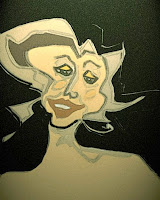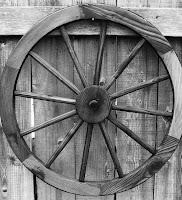When Your Nest When your nest runneth over and your child’s broke a bone tumbling down the slope and the other child grows in patience and in sympathy we don’t believe in love; we don’t believe, we know.
Posts
Showing posts from April, 2010
Alchemy and Metaphor
- Get link
- X
- Other Apps
. The American Heritage Dictionary defines a metaphor as: “A figure of speech in which a word or phrase that ordinarily designates one thing is used to designate another, thus making an implicit comparison” They give as an example Shakespeare’s “all the world’s a stage.” Clearly all the world is not a stage but Shakespeare had the line delivered from a stage and compared the people of the world to actors playing their parts. It was more than a century before Shakespeare that the word metaphor came into English and it did so in a most appropriate document. The year was 1477 and the document something called The Ordinall of Alchimy by one Thomas Norton. This is actually a kind of poem about the secrets of alchemy and the reason that the subject of alchemy is so appropriate for the word metaphor is that writings on alchemy written by alchemists had always been as obscure as possible and used piles of metaphor in favour of straightforward explanations on how to turn lead into gold. The aut...
Wilbur on Trismegistus
- Get link
- X
- Other Apps
O Egypt, Egypt —so the great lament Of thrice-great Hermes went— Nothing of thy religion shall remain Save fables, which thy children shall disdain. His grieving eye foresaw The world’s bright fabric overthrown Which married star to stone And charged all things with awe. And what, in that dismantled world, could be More fabulous than he? Had he existed? Was he but a name Tacked on to forgeries which pressed the claim Of every ancient quack— That one could from a smoky cell By talisman or spell Coerce the Zodiac? Still, still we summon him at midnight hour To Milton’s pensive tower, And hear him tell again how, then and now, Creation is a house of mirrors, how Each herb that sips the dew Dazzles the eye with many small Reflections of the All— Which, after all, is true.
J.V. Cunningham
- Get link
- X
- Other Apps
. For My Contemporaries How time reverses The proud in heart! I now make verses Who aimed at art. But I sleep well. Ambitious boys Whose big lines swell With spiritual noise, Despise me not! And be not queasy To praise somewhat: Verse is not easy. But rage who will. Time that procured me Good sense and skill Of madness cured me.
Synaethesia
- Get link
- X
- Other Apps
. . via Inky Fool: She smelled the way the Taj Mahal looks by moonlight. (- The Little Sister by Raymond Chandler) Synaethesia is either a mental condition whereby colours are perceived as smells, smells as sounds, sounds as tastes etc, or it is a rhetorical device whereby one sense is described in terms of another. If colours are harmonious, or a voice is silky, that is synaesthesia (or some other spelling). It is a common enough device, except that there seem to be rules, or norms governing which senses can be coupled. Sight and sound are interchangeable. Quite aside from John Lennon's request to George Martin that the orchestration of Strawberry Fields should be "orange", colours can be loud or discordant while melodies can be bright and rumblings dark. Tone is even an ambiguous word that can be applied to either sense, and I thoroughly recommend Ernest Bloch's Sketches in Sepia. (I omit colours that are purely symbolic: blues music is no more blue than blue movies...
Socrates Cafe, April
- Get link
- X
- Other Apps
. This month we gathered to consider the question of Morality. Moral relativism was invoked in many languages. As was absolutism. As were Fyodor, Nietzsche, Gandhi, Camus, Hitler, and various deities and prophets. Several confused morality with contemporary righteousness and bible thumping. Societal influences and instinctual impulses were poked and prodded. Morality and Ethics were compared and contrasted. Semantics and ideas were bent, blunted, blurred and collected. I said, To speak of morality, one must speak of immorality -- and of both in their rhetorical extremes. The concensus replied: There is no such thing as evil. Said one woman, there are evil acts, but there is no such thing as an evil person. Said another: What do you call a person who makes shoes ? A shoemaker, she replied. Ah, he said. -- Perhaps in our collective and rational eschewing of religion and mythology, we have also eschewed philosophy, imagination, and wisdom. But certainly not morality.
The Ampersand
- Get link
- X
- Other Apps
The ampersand itself is thousands of years old but the name we use for it is only a couple hundred years old. It's a pictograph, or more accurately a logogram, and it’s so useful that Europeans have been addicted to it ever since it was invented. It was invented by Marcus Tullius Tiro, who was born a slave but proved smart enough that Cicero freed him and hired him to keep track of speeches and things. In Latin the way they said “and” was et. If you squish the two letters of et into a single character, what do you come up with? The ampersand: &. Two, three and four hundred years ago this little squiggle was useful enough that children were taught it right along with their ABCs. At the end of the alphabet, it was usual during this period to have the ampersand as the last “letter” following the Z. So when kids were reciting their ABCs and they got to the end they didn’t stop at “w, x, y and z” instead they said “w, x, y, z and per-se and.” This is because for this symbol they wer...
Reviewers and the Cliche'
- Get link
- X
- Other Apps
Top Twenty Eye-Rollers Used in Book Reviews: 1. Gripping 2. Poignant 3. Compelling 4. Nuanced 5. Lyrical 6. Tour de force 7. Readable 8. Haunting 9. Deceptively simple 10. Rollicking 11. Fully realized 12. At once 13. Timely 14. ” X meets X meets X 15. Page-turner 16. Sweeping 17. That said 18. Riveting 19. Unflinching 20. Powerful Best comment to the list: In my house, a page-turner is a book I skimmed. via: http://www.examiner.com/x-562-Book-Examiner~y2009m3d11-The-top-20-most-annoying-book-reviewer-phrases-and-how-to-use-them-all-in-one-meaningless-review



















